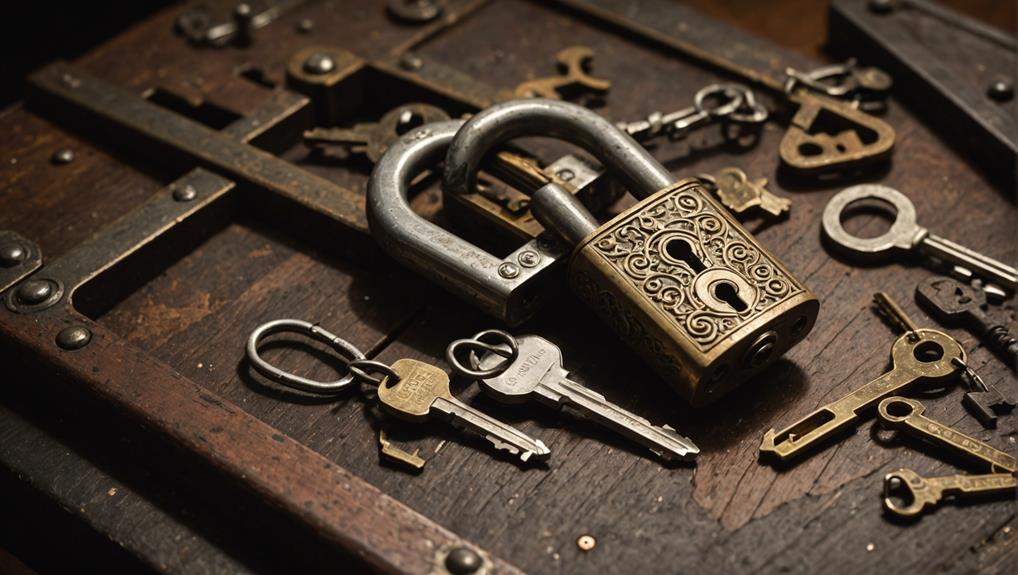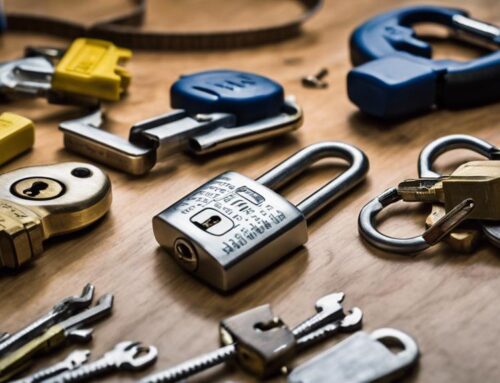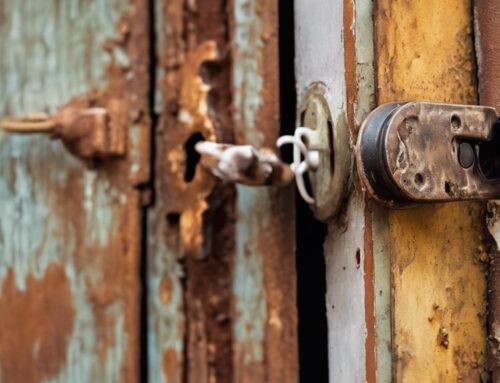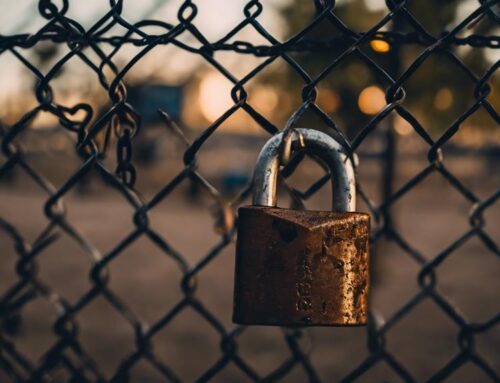Rekeying antique and vintage locks can be tricky because each lock has unique mechanisms and historical significance. You'll need to assess the lock's condition carefully and gather the right tools. One wrong move can compromise the lock's integrity or security. Finding a qualified locksmith with experience in antique locks is essential, as they understand the delicate nature of these pieces. Additionally, legal considerations around ownership can complicate the process. Maintaining the historical value while ensuring functionality demands a thoughtful approach. If you're curious about specific techniques and best practices, there's plenty more to discover.
Key Takeaways
- Rekeying antique locks requires specialized knowledge to preserve their historical integrity while ensuring functionality and security.
- Improper rekeying can lead to malfunctioning locks, increasing vulnerability, and risking unauthorized access.
- Assessing the lock's condition is crucial, as worn or damaged parts may complicate the rekeying process.
- Finding a qualified locksmith with experience in antique locks is essential for successful rekeying and maintenance.
- Regular maintenance, including cleaning and lubrication, helps prolong the lifespan and functionality of antique locks.
Understanding Antique Locks
Antique locks are fascinating pieces of history that showcase the craftsmanship of their time. When you look closely at these locks, you'll notice unique designs and intricate mechanisms that reflect the skills of artisans from bygone eras.
Understanding the importance of preserving antique locks is essential, especially if you're passionate about serving others. Re-keying vintage locks involves ensuring security while maintaining compatibility, which is vital for these historical pieces. These locks often hold sentimental value and play a role in the stories of families.
Rekeying antique locks can be a delicate process. You'll need to approach it with care and respect, ensuring that you don't damage the lock's historical integrity. Vintage lock rekeying isn't just about making a key fit; it's about maintaining the story behind the lock while enhancing security for its current owner.
When preserving antique locks, it's vital to clean them gently and store them properly to prevent deterioration. This practice not only honors the craftsmanship but also serves those who cherish these treasures.
Common Types of Vintage Locks

When exploring the world of vintage locks, you'll encounter a variety of styles, each with its own unique characteristics and historical significance. Common types include the padlock, often used for gates and storage, and the mortise lock, which fits into the door itself for added security.
Additionally, understanding the concept of lock re-keying can enhance your appreciation for these locks, as it allows for modern functionality while preserving historical value the benefits of re-keying. You'll also find rim locks, frequently seen on older homes, and cylinder locks, which have become popular over the years for their practical design.
Understanding these types is essential, especially when you're considering how to rekey old locks. Rekeying historical locks requires a delicate touch and respect for their craftsmanship. You'll want to preserve the integrity of the lock while ensuring it functions effectively for modern use.
Each vintage lock tells a story, reflecting the time it was made and the craftsmanship involved. By learning about their unique features, you can better serve those who appreciate these pieces of history.
Whether you're a collector or just someone looking to secure a treasured item, knowing the common types of vintage locks will help you navigate the process of rekeying with confidence and care.
Identifying Unique Mechanisms

Understanding the intricacies of vintage lock mechanisms can be a rewarding experience for enthusiasts and collectors alike. When you explore identifying unique mechanisms, you'll discover that each lock tells its own story.
Start by examining the lock's design features, such as the keyhole shape, the number of pins, and any distinctive markings. These elements can help you determine the manufacturer and the era it represents. In some cases, vintage locks may incorporate advanced technologies, such as high-security locking features, which can distinguish them from standard locks of their time.
Don't overlook the materials used in construction, as they often indicate a lock's age and origin. Look for signs of craftsmanship, like intricate engravings or unique finishes.
Remember, some mechanisms may incorporate unusual features, like lever systems or complex tumbler arrangements, which can signify a higher level of security or innovation for their time.
As you identify these mechanisms, document your findings. Sharing this information can't only enhance your understanding but also serve others in their quest for knowledge.
Whether you're restoring a lock for practical use or as a collectible piece, recognizing its unique attributes will enrich the experience and help preserve the art of antique locking mechanisms for future generations.
Assessing Lock Condition

Before diving into re-keying an antique or vintage lock, you need to assess its condition thoroughly. Start by examining the lock's exterior for signs of rust, corrosion, or physical damage. These factors can affect the lock's functionality and integrity. If you notice significant wear, consider whether the lock can be successfully re-keyed or if it's time to look for a replacement.
Next, check the internal mechanism. If you've access, open the lock to inspect the pins and springs. Confirm they're not worn down or broken. A lock with malfunctioning internal parts may require more than just re-keying; it might need complete restoration.
Don't forget to test the lock's operation. Turn the key or manipulate the mechanism to see if it moves smoothly. Any sticking or grinding could indicate deeper issues that need addressing.
Tools Required for Rekeying

Once you've assessed the condition of your antique or vintage lock, gathering the right tools for re-keying is your next step. You'll need a few essential items to guarantee the process goes smoothly.
Start with a quality pinning kit, which includes various sizes of pins that match the lock you're working on. A set of small screwdrivers will help you open the lock casing without damaging it. According to essential tools for lock re-keying, having a follower is vital, as it's a tool that keeps the lock cylinder together while you replace the pins.
Additionally, a good pair of tweezers is invaluable for handling those tiny pins and springs. A flashlight can help you see inside the lock, especially in dim lighting or hard-to-reach areas. You might also want a small magnet to catch any dropped pins, preventing them from getting lost.
Lastly, having a notebook handy is beneficial for jotting down any observations or steps you take during the process.
With these tools at your disposal, you'll be well-equipped to re-key your antique or vintage lock, guaranteeing it serves its purpose for years to come. Happy re-keying!
Techniques for Preservation

Preserving antique and vintage locks requires careful attention to detail to guarantee they maintain their aesthetic and functional qualities. Start by cleaning the surface with a soft cloth to remove dust and grime. Avoid harsh chemicals; instead, use mild soap and water, ensuring you don't soak the lock. For rust, a light application of penetrating oil can help, but be sure to wipe off any excess.
When to replace rusty locks is a significant consideration, as substantial rust can compromise the security and functionality of these pieces.
Next, consider applying a protective wax or lacquer to shield the lock from moisture and air, which can cause deterioration. If the lock has moving parts, use a few drops of machine oil to keep them functioning smoothly—just don't overdo it, as too much oil can attract dust.
When storing, keep locks in a climate-controlled environment, away from direct sunlight and humidity, to prevent warping and tarnishing. If you're displaying them, consider using shadow boxes or glass cases to minimize exposure to harmful elements.
Ultimately, the goal is to honor these historical pieces while ensuring they remain functional. By following these preservation techniques, you'll not only protect their beauty but also serve future generations who appreciate their craftsmanship.
Risks of Improper Rekeying

Improper rekeying can lead to significant security risks and functional issues with antique and vintage locks. If you attempt to rekey a lock without the right knowledge or tools, you might compromise its integrity.
For instance, using incorrect pins can prevent the lock from functioning smoothly, leaving it vulnerable to tampering or break-ins. In fact, when DIY lock re-keying isn't advisable can often apply to these unique locks due to their complexity and historical value.
Additionally, if the lock isn't rekeyed properly, it may inadvertently allow old keys to still operate it. This poses a serious risk, especially if those keys are still in circulation. The last thing you want is for someone with an old key to gain unauthorized access to a cherished heirloom or a historic property.
Moreover, improper rekeying can lead to frustration when the lock fails to work as intended. If you're serving others by maintaining their antique locks, a malfunctioning lock can damage your reputation.
It's vital to remember that antique and vintage locks are often intricate and require a delicate touch. By recognizing the risks of improper rekeying, you can guarantee the security and functionality of these valuable pieces, providing peace of mind to those who trust you with their treasured possessions.
Finding Professional Help

When you're ready to re-key your antique or vintage locks, finding the right professional help is essential.
It's important to recognize that these locks often have unique mechanisms that require specialized knowledge, so seeking out a locksmith experienced in dealing with such intricacies can save you time and frustration.
Start by identifying qualified locksmiths who specialize in these unique mechanisms, then evaluate their experience and expertise.
Finally, assess service costs to guarantee you get quality work without breaking the bank.
Identifying Qualified Locksmiths
Finding a qualified locksmith for antique and vintage locks can be a challenging task, but it's essential for ensuring the integrity of your cherished pieces.
You want someone who understands the nuances of these locks and treats them with the care they deserve. To identify a trustworthy professional, consider the following essential factors:
- Experience with Antique Locks: Look for locksmiths who specialize in antique and vintage locks, as they'll have the necessary skills and knowledge.
- Positive Reputation: Seek out reviews and testimonials from previous clients. A reputable locksmith will have positive feedback and a history of satisfied customers.
- Professional Associations: Check if they belong to professional locksmith organizations. Membership often indicates a commitment to ongoing education and high standards.
Evaluating Experience and Expertise
Choosing the right professional to work on your antique and vintage locks is essential, as their experience can greatly impact the lock's functionality and value.
When seeking help, look for locksmiths who specialize in antique mechanisms. Their familiarity with the intricacies of these locks can prevent potential damage that less experienced professionals might cause.
Ask about their background—how long have they been working with antique locks? A seasoned locksmith will have a wealth of knowledge about various lock types and the specific techniques required for re-keying them.
Inquire about their previous projects and ask for references. Hearing from satisfied customers can help you gauge their expertise.
Additionally, consider whether the locksmith is a member of professional associations. Membership often indicates a commitment to ongoing education and best practices in the field.
Assessing Service Costs
Understanding the costs associated with re-keying antique and vintage locks helps you make informed decisions while seeking professional assistance.
When exploring your options, it's crucial to take into account not just the price but also the value you're getting. Here are some factors that can influence service costs:
- Lock Type: The complexity of the lock mechanism can greatly affect the re-keying price. Unique designs may require specialized skills.
- Condition of the Lock: If the lock is in poor condition, additional repairs might be necessary, affecting the overall cost.
- Local Market Rates: Prices can vary widely based on geographic location and the availability of skilled locksmiths.
When you're ready to get help, it's wise to obtain multiple quotes. This way, you can gauge the average cost and find a professional who aligns with your budget while guaranteeing quality service.
Best Practices for Maintenance

To keep your antique and vintage locks in top shape, regular cleaning is essential. This not only preserves their aesthetic appeal but also prevents dirt and grime from affecting their functionality.
You'll also want to apply the right lubrication and handle them with care during storage. By following these best practices, you can guarantee your locks remain functional and beautiful for years to come.
Additionally, understanding the importance of the re-keying process can help maintain the security of your home while preserving the integrity of these unique locks.
Regular Cleaning Techniques
Regular cleaning is vital for maintaining the integrity and functionality of antique and vintage locks. Dust, dirt, and grime can accumulate, leading to potential malfunctions over time.
By adopting a consistent cleaning routine, you can help preserve these beautiful pieces and guarantee they continue to serve their purpose effectively.
Here are some best practices for cleaning your antique and vintage locks:
- Use a soft brush: Gently remove dust and debris from the lock's surface and crevices using a soft-bristled brush. This minimizes the risk of scratches or damage.
- Apply a mild cleaning solution: For tougher stains, mix water with a few drops of mild soap. Dampen a cloth with the solution and wipe the lock, avoiding excessive moisture.
- Dry thoroughly: After cleaning, use a dry cloth to make sure there's no residual moisture. This step is essential to prevent rust and corrosion.
Lubrication and Care
Proper lubrication is essential for the longevity and smooth operation of antique and vintage locks. Regular maintenance helps prevent rust, reduces wear, and guarantees that the lock functions properly. Here are some best practices you can follow to care for these delicate mechanisms.
| Lubricant Type | Application Method | Frequency |
|---|---|---|
| Graphite Powder | Apply directly into the keyhole & mechanism | Every 6 months |
| Silicone Spray | Lightly spray on moving parts | Every 3-6 months |
| Oil (Light) | Use a dropper to apply to the pins | Once a year |
When lubricating your antique locks, remember to apply sparingly. Too much lubricant can attract dust and grime, which can impede functionality. Always clean the lock before applying any lubricant to guarantee that you're not trapping dirt inside. Regularly check the lock's operation and lubricate as needed. By following these practices, you can help preserve the beauty and function of these vintage treasures for years to come, allowing others to appreciate their history.
Storage and Handling Tips
Storing and handling antique and vintage locks with care can greatly extend their lifespan and functionality.
These delicate pieces require special attention to guarantee they remain in excellent condition. Here are some best practices to follow:
- Keep them dry: Moisture can lead to rust and corrosion. Store your locks in a dry environment, using silica gel packets to absorb excess humidity.
- Use protective storage: Store locks in padded containers or boxes to prevent scratches and damage. Avoid stacking them directly on top of each other.
- Handle with clean hands: Oils and dirt from your hands can harm the finish. Always wear gloves or guarantee your hands are clean before handling.
Legal Considerations in Rekeying

When it comes to rekeying antique and vintage locks, there are several legal considerations you should keep in mind. First, verify you have the rightful ownership of the lock. Rekeying someone else's property without permission can lead to legal disputes. If you're working on behalf of a client or a family member, getting written consent can help avoid misunderstandings.
It's also important to understand the legal obligations regarding rekeying after a tenant moves out, as this varies by state and can impact your responsibilities if you're managing rental properties understanding tenant laws.
Next, be aware of local laws regarding locksmith services. Some jurisdictions require specific licensing for locksmiths, especially when dealing with historical locks. If you're not a licensed locksmith, you may want to collaborate with one to confirm compliance.
Additionally, if the lock has historical value, consult with preservation experts to avoid damaging it during the rekeying process. The integrity of vintage items must be maintained, as altering them improperly could violate preservation laws.
Lastly, keep detailed records of the rekeying process. This documentation can be vital for future owners or restorers who may need to understand the changes made to the lock.
Frequently Asked Questions
Can All Antique Locks Be Successfully Rekeyed?
Not all antique locks can be successfully rekeyed. Some designs are too intricate or fragile, making it difficult to replace their internal mechanisms.
Additionally, finding the correct key or pins for older models can be a challenge. However, many antique locks can still be serviced or repaired, allowing you to maintain their charm while ensuring functionality.
If you're unsure, consult a locksmith experienced with vintage pieces to explore your options.
How Do I Determine the Value of My Antique Lock?
To determine the value of your antique lock, start by researching its age, manufacturer, and condition.
Look for any unique features or markings that might indicate rarity.
Check online marketplaces and auction sites for similar locks to gauge pricing.
Consulting with an expert or appraiser can also provide insights.
What Are the Signs of a Poorly Rekeyed Lock?
When you're evaluating a lock that's been poorly rekeyed, look for loose levers, lingering latches, and a lack of smoothness in operation.
If the key sticks or feels unsteady, that's a sign of shoddy work. You might also notice misaligned mechanisms or mismatched keys that don't fit snugly.
Each of these flaws can hinder security, so trust your instincts and seek help from a professional to guarantee safety and reliability.
Are There Specific Laws Regarding Antique Lock Modifications?
Yes, there are specific laws regarding modifications to antique locks, though they can vary by location.
You should check local regulations to verify compliance, especially if the locks are part of historically significant properties.
It's crucial to preserve the integrity of these items while serving your community's historical interests.
Consulting with a professional experienced in antique restoration can help you navigate these laws and maintain the value of your antique locks.
How Do I Choose the Right Locksmith for Antique Locks?
When you're choosing a locksmith for antique locks, it's essential to verify their expertise. Not all locksmiths understand the intricacies of vintage mechanisms.
Look for someone with experience specifically in antique locks and a strong reputation. Ask for references and check reviews to guarantee they're trustworthy.
You want a locksmith who respects the history of your piece while providing skilled service. Ultimately, their knowledge can help preserve the charm of your lock.
Conclusion
Rekeying antique and vintage locks can be a rewarding journey, but it's not without its challenges. By understanding the unique mechanisms and evaluating each lock's condition, you can avoid the pitfalls of improper rekeying. Remember, this process is like walking a tightrope; one misstep could lead to disaster. If you're unsure, don't hesitate to seek professional help. With proper care and maintenance, those charming locks can keep their secrets safe for many years to come.









